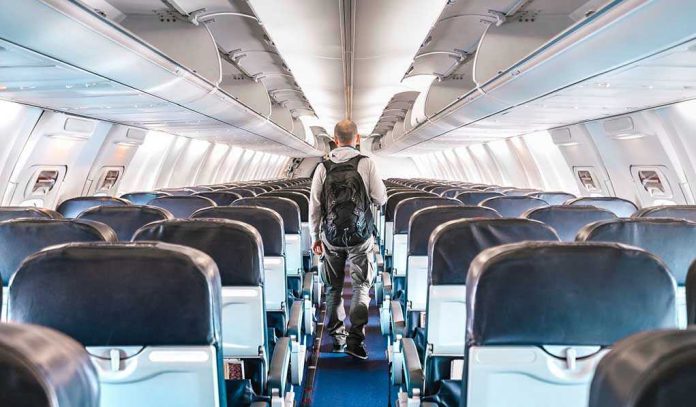
When 25 people ended up hospitalized after a Delta jet hit sudden, violent turbulence, it exposed a glaring reality: even in the most advanced aircraft, chaos can strike without warning—leaving Americans to wonder if safety is still truly a priority at 35,000 feet.
At a Glance
- Delta Flight 56 from Salt Lake City to Amsterdam diverted after severe turbulence injured 25 passengers and crew
- Incident occurred over Wyoming during meal service, a time when many travelers were unbuckled
- All injured were hospitalized after emergency landing in Minneapolis; the FAA is investigating
- Recent turbulence incidents highlight gaps in airline safety and turbulence forecasting
Severe Turbulence Throws Airline Safety into the Spotlight
Delta Air Lines Flight 56 was supposed to be a routine transatlantic journey. Instead, it turned into a harrowing ordeal that sent 25 people to hospitals and left 275 passengers and 13 crew members shaken, battered, and grateful to be alive. The Airbus A330-900 was about 45 minutes out from Salt Lake City, cruising over Wyoming’s notorious weather corridors, when the cabin was rocked by an unanticipated burst of severe turbulence. The timing couldn’t have been worse—meal service was underway, meaning passengers and crew were moving about and seat belts were unfastened, just as the jet encountered an atmospheric sucker punch that nobody saw coming. The flight crew, trained for crisis but never hoping to use those skills, made the split-second decision to divert to Minneapolis-St. Paul International Airport. There, a small army of emergency responders stood ready to treat the injured and get them to local hospitals for evaluation and care.
Air travel is pitched as the safest way to get from point A to point B, but this incident—like so many others in recent years—shows how quickly things can spin out of control. Passengers on board reported fractured ribs and a range of other traumas. And while Delta’s Care Team was quick to offer support and the FAA swiftly announced an investigation, the fact is, passengers were left exposed because turbulence forecasting and real-time warning systems simply aren’t good enough. It’s the kind of event that makes you question how much of modern airline safety is really just a roll of the dice, and how much is actually within our control.
Crisis Response and the Realities of Airline Protocols
After the plane touched down safely in Minneapolis, emergency services went into overdrive. Twenty-five people—passengers and crew alike—were rushed to local hospitals. The rest, stunned but mostly unhurt, waited for answers and onward travel arrangements. Delta, for its part, issued the kind of statement we’ve all heard before: “Safety is our No. 1 value at Delta, and our Delta Care Team is working directly with customers to support their immediate needs.” That’s cold comfort for the folks who ended up in hospital beds with broken bones. The FAA opened its investigation, as it always does. But let’s be honest: investigations rarely fix the underlying issues. Airlines may tweak a protocol, add a new line to the pre-flight safety spiel about keeping your seat belt fastened “whenever you’re seated”—but will that stop a service cart from becoming a missile when the skies turn rough? Not likely. This is just the latest in a series of similar incidents—remember Singapore Airlines just last year, and Lufthansa before that? Each time, the airline industry promises to “do better,” but the same headlines keep coming back around.
For the travelers on Flight 56, the consequences were immediate and personal: injuries, ruined plans, and a shaken faith in the system. For Delta, it’s another PR nightmare and a test of their crisis management playbook. For the flying public, it’s a reminder that sometimes, despite all the technology and all the assurances, turbulence is still a wild card no one can reliably predict or prevent.
Regulatory Scrutiny and the Push for Real Solutions
The FAA’s investigation is now underway, but there’s already talk—again—about whether more can be done to protect passengers from these airborne ambushes. Aviation safety experts point out the obvious: seat belts save lives, but only if people are wearing them. Yet, during meal service, that’s not always possible. Meteorologists have long warned that clear-air turbulence is especially dangerous because it’s invisible to the naked eye and radar. That leaves both flight crews and passengers vulnerable. Some experts are calling for stricter seat belt rules, while others want big investments in turbulence detection technology—something the airlines have dragged their feet on for years, citing cost and implementation hurdles. There’s also a growing body of research suggesting that turbulence is getting worse thanks to shifting jet streams and atmospheric instability—trends that could make incidents like this more common in the future. For now, the FAA may recommend new safety measures, but the industry’s track record on quick, meaningful reform is spotty at best.
Ultimately, the people who pay the price are the same ones who always do: the regular, law-abiding Americans who just want to get from point A to point B without winding up in a hospital. As regulatory agencies deliberate and airlines scramble to manage the fallout, it’s clear that the turbulence problem isn’t just a weather issue—it’s a test of whether anyone in the system is willing to put real solutions ahead of cost-cutting and PR. And if history is any guide, don’t hold your breath for meaningful change.
Sources:
ABC News: 25 hospitalized after severe turbulence on Delta flight
CBS News: Minneapolis airport emergency landing after turbulence injuries













